
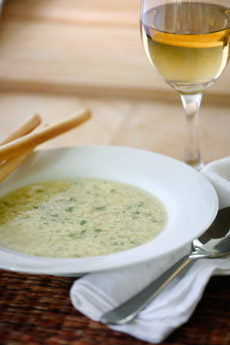
Stracciatella soup is similar to Chinese egg drop soup. Photo courtesy DiLallo Foods.
April 2010
Last Updated December 2013
|
 |
Soup Types: O To S
Page 5: From Oxtail Soup To Stracciatella
This is Page 5 of a six-page glossary. It features oxtail soup, oyster cracker, ramen, stracciatella and other soup-related terms from O to S. There are thousands of soups in the world’s cuisines; terms featured are soups likely to be found in the U.S. Click on the black links below to visit other pages. And check out our many other food glossaries.
ONION SOUP
See French onion soup.
OXTAIL SOUP
Oxtail soup is made with beef tails. In the past, when oxen were common, the tail of the ox was used. Different versions of oxtail soup exist in Chinese, English, Indonesian Korean and Southern American cuisine. The English version is a thick, rich, gravy-like soup. Creole oxtail soup has a tomato and oxtail base with garlic, herbs, potatoes and other vegetables.
OYSTER CRACKER
Oyster crackers are small, salted, soup crackers, typically hexagonal in shape and molded into two halves, roughy suggestive of an oyster shell. They were invented by Adam Exton, who opened a bakery in Trenton, New Jersey in 1846. The crackers were so-named because they were commonly served with oyster chowder, stew and similar fish and seafood dishes. They are made from wheat flour, yeast and vegetable shortening plus leavening, malted barley flour and salt. |
|

Oyster crackers. Photo courtesy Shamanshop.net. |
PASTA E FAGIOLE
Literally, pasta and beans, this meatless peasant dish was brought to the U.S. by Italian immigrants. The recipe uses dried borlotti beans (cranberry beans) or cannellini beans (white kidney beans) and a small cut pasta such as ditalini or elbow macaroni. Olive oil, stewed tomatoes (or tomato paste), garlic, minced onion, and spices are added. Some recipes use a broth, which makes a soup-like version.
PEPPERPOT or PEPPER POT SOUP
Pepperpot soup, also made in a thicker stew version, is a hearty beef and potato soup (originally beef tripe was used). The soup includes onions, bell peppers, other vegetables selected by the cook, and ground black pepper. Two U.S. presidents—George Washington and FDR—chose pepper pot as their most requested soup recipe. One story says that the soup was created from inexpensive ingredients during the Revolutionary War to feed the starving Continental Army. It is also called Philadelphia Pepper Pot Soup after an early 19th century painting by John Lewis Krimmel titled Pepper-Pot: A Scene in the Philadelphia Market. The painting depicts a street vendor selling the soup. |
|
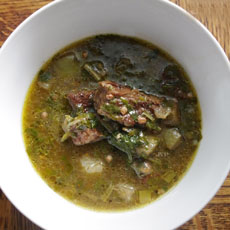
Pepperpot soup, a favorite of two presidents. Photo courtesy Tomatosnob | Blogspot.com |
Campbells made a version for many years, but it was discontinued in 2010 in favor of higher-profitability soups (see the discussion here). It contained many ingredients including stock, beef tripe, carrots and macaroni.
PHO
Pho is a complex and flavorful Vietnamese beef broth, piled high with stewed beef, noodles, basil, bean sprouts, cilantro, onions, scallions and a great complexity of spices: chile, cinnamon, star anise, ginger, black cardamom, coriander, fennel and clove. It is topped off with fresh lime squeezed at the table. A symphony of flavors, it is one of the world’s great soups. Here’s the history of pho and a recipe to make it at home. |
|
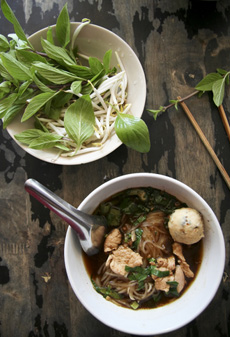
Pho: one of the world’s great soups. Photo © Simon Gurney | Dreamstime. |
PURÉE
Purées are soups made from boiling vegetables that are strained into a smooth pulp. A good purée has the consistency of thick cream. Starchy vegetables (beans, peas, lentils, potatoes) don’t require an additional starch thickener. Other vegetables—beets, bell peppers, carrots, celery, leeks and tomatoes, for example—may require a thickener to achieve a consistency like the one in the photo.
|
|
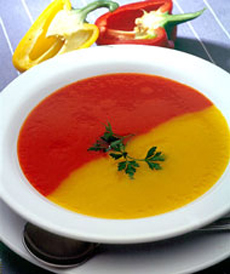
How impressive: a double purée, red and yellow bell pepper soups. |
RAMEN NOODLE SOUP
While most Americans think of ramen as an inexpensive instant soup meal, instant ramen were invented in 1958 by Momofuku Ando, the Taiwanese-Japanese founder and chairman of Nissin Foods. Long before then, ramen was a respected dish called shina soba, or Chinese soba (today chuka soba, also meaning Chinese soba, is more common). The style of noodle made from white wheat flour came from China, and contrasted with the buckwheat soba noodles of Japan. By 1900, restaurants serving Chinese cuisine from Canton and Shanghai offered a simple ramen dish of noodles (cut rather than hand pulled like soba), a few toppings and a broth flavored with salt and pork bones. It might be “simple,” but it’s a gourmet delight compared to the salty instant ramen dish from the cellophane package! |
|
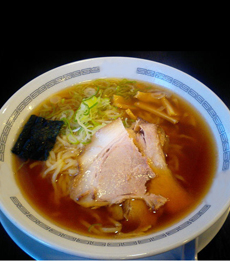
“Real” ramen soup. Photo courtesy Wikimedia. |
SCOTCH BROTH
A hearty barley soup originating in Scotland, where it was based on lamb or mutton stock, Scotch broth is often found in the U.S. made with a beef stock. It retains the root vegetables of the original recipe (carrots and turnips) and any variety of dried beans.
SHE CRAB SOUP
A specialty of Charleston, South Carolina, she crab soup is considered the signature dish of the city. It’s a cross between a bisque and a chowder, made with the local blue crab meat and topped with crab roe. Scottish settlers in the 1700s brought recipes for seafood bisques, and one of the rich soups became de rigeur at any fine dinner. The addition of the crab roe is a much later addition, credited to William Deas, a butler and a cook to R. Goodwyn Rhett, a mayor of Charleston. According the story, the recipe was created for a visit of President William Howard Taft, sometime between 1908 and 1912. Deas was asked to “dress up” the pale crab soup and he did so with the orange crab roe, giving birth to She Crab Soup.
SOUP
A liquid food that can contain solid pieces. It is prepared by boiling ingredients—fish and/or seafood, meat or vegetables—in water and with seasoning. There are also dessert soups made from fruit and spices. The thickness of the soup may be adjusted using a thickener. A soup can be a humble and rustic dish made with the most inexpensive ingredients—onions and potatoes, for example—or a very elegant one made with lobster stock and garnished with caviar.
SOUP CRACKERS
Soup crackers refer to oyster crackers. Some people include saltines in the category.
|
|
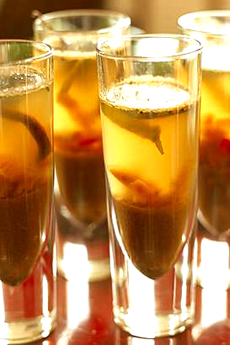
An elegant lemongrass soup from Indian Home Cooking. |
STEW
A stew is a soup with butter and milk or cream. The term is generally used with shellfish recipes—cubes of lobster for lobster stew and whole oysters in oyster stew, for example (see photo). The thickness and richness of a stew differentiates it from a soup. Oyster soup, for example, would have water, no butter and less cream or milk, for a much thinner and less creamy dish.
|
|
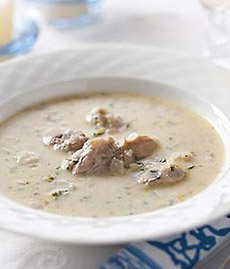
Oyster stew. Photo courtesy MackenzieLtd.com. |
STOCK
Stock is a liquid in which leftover flesh, bones (or shells, in the case of seafood stock) and vegetables have been boiled to create a flavored base. Any part of the animal that is not desired for eating can be used—feet, head, neck, etc. The bones contribute gelatin to the liquid, as well as flavor. The flavor is extracted by long, slow cooking. Often, stock is prepared in advance and reserved in the refrigerator or freezer for soup-making and other recipes. Higher-gelatin stocks make a better base for sauces. The difference between a stock and a broth is the seasoning. Stock is not seasoned; it is an unfinished product that is an ingredient in another dish.* Bouillon cubes are often used in recipes, instead of a stock prepared from scratch. But like any quick fix, the flavor of instant bouillon cubes can’t compare to a reduced stock. Premade stocks can be purchased at retail, some better (more flavorful) than others.
|
|
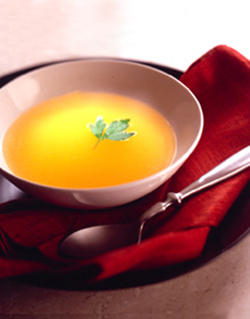
Our favorite prepared stock is from Savory Choice.
*Stock is used to make gravy, marinades, risotto, sauces and other soups. Beef stock is also used for au jus.
|
Lifestyle Direct, Inc. All rights reserved. Images are the copyright of their individual owners.

|












